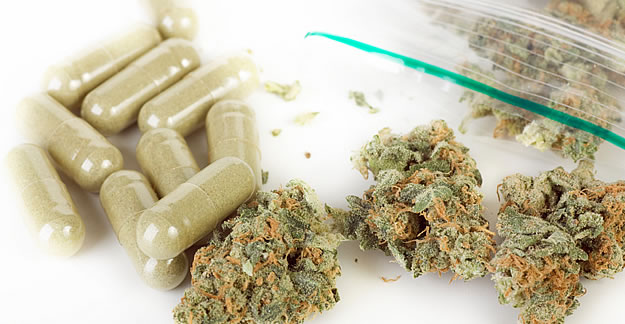Browse This Article
Medical marijuana easing pain, and lessening side effect for people fed up with the side-effects of conventional medications
In the fall of 2012, 9 months after starting chemotherapy for Stage 3 colon cancer, Shannon Flowers of Seattle developed nerve pain in her hands and feet that was so intense she couldn’t sleep at night. Two commonly prescribed medications for neuropathy – Lyrica and gabapentin — certainly helped, but the side effects, she remembers, were “horrible,” everything from severe swelling in her extremities to mood swings, chronic exhaustion and hunger.
Fed up with the side-effects of conventional medications, Flowers turned to an unconventional but increasingly popular (as well as legal) alternative: medical cannabis, commonly referred to as medical marijuana.
In 1999, only three states – Alaska, California and Maine – had laws permitting the use of medical marijuana. Today, 21 states and the District of Columbia authorize the use of medical marijuana, primarily to help people with chronic conditions alleviate the severe side effects of the conventional medications they take for cancer treatment, glaucoma, HIV infection, nerve pain, nausea, epilepsy, Crohn’s disease, multiple sclerosis and other chronic conditions.
Many of the estimated 2.5 million Americans who have used medical marijuana have even been able to reduce their dependence on prescription medicine by adding cannabis to their treatment regimen.
Once a prominent opponent of medical marijuana, Sr. Sanjay Gupta, CNN’s Chief Medical Correspondent, famously reversed course in August 2013 after touring the country and seeing how cannabis was helping people fight illness and lessen their need for prescription medicines, including a 3-year-old Colorado girl who was experiencing 300 seizures a week despite being on 7 different medications. Medical marijuana, he says, “calmed her brain,” and lowered her seizure count to 2 to 3 a month.
Medicinal use of cannabis dates back at least 3,000 years, when people in China and Egypt were using it to treat such problems as leprosy, pain and inflammation. In the United States, federal law still classifies marijuana as an illegal narcotic, yet states have been allowed to pass their own medical marijuana laws.
So far, 21 states, as well as the District of Columbia, have already legalized medical marijuana for a broad variety of medical problems, many of which are severe reactions to traditional medications. According to the Marijuana Policy Project, a Washington, D.C-based advocacy group, medical marijuana has most often been approved for treating cancer, glaucoma, nerve pain (or neuropathy), the wasting syndrome that often comes with HIV infection, severe chronic pan, severe nausea, and the often hard-to-treat spasticity — or muscle stiffness – that may affect more than 70 percent of multiple sclerosis sufferers.
Laura Oxley, a spokeswoman for the Arizona Department of Health Services, said that while her state’s current data gathering system doesn’t allow health officials to know exactly which drugs medical marijuana is replacing or supplementing, there is “tremendous public support” for medical cannabis use in general. So far, 70 medical marijuana dispensaries are open in Arizona, and the state has approved another 85 new facilities.
The Challenges of Researching Federally Banned Substances
Despite strong public support for medical marijuana use, some studies suggest that medical marijuana’s therapeutic effects are modest at best, while others indicate it may be most useful for helping those individuals who aren’t getting help from conventional drugs, or who can’t deal with the side effects of those medications. Some physicians, meanwhile, caution that because marijuana is still a federally banned substance, the science behind medical marijuana is emerging slowly; larger and more rigorous clinical studies are needed. In laboratory and animal studies, for example, the active chemicals in medical marijuana either kill or inhibit cancer cells, yet clinical studies so far have not looked at medical marijuana as a cancer treatment for people, except for a small but promising study on glioblastoma.
“It’s being prescribed for conditions for which there is no scientific basis to know that it works,” said Dr. J. Hampton Atkinson, the Co-Director for the Center for Medicinal Cannabis Research at the University of California, San Diego.
Julie Falco of Chicago was taking 30 drugs to help with the painful symptoms of MS. She traded them in for just one: medical marijuana. “The cannabis didn’t eliminate anything (like tremors), but within the first week I noticed an improvement so I could walk a little better, and also I wasn’t feeling as depressed,” she said, adding that the only side effect so far has been dry mouth, which she treats by drinking more water.
Still, many medical marijuana users remain firmly committed to the therapy. In Washington State, where medical cannabis has been legal since 1998, Shannon Flowers is using a syringe or dropper to take tiny amounts of either “hash oil” or a marijuana-based tincture orally to help fight her nerve pain (smoking marijuana is not an option because she’s asthmatic). Early on, she discovered the cannabis was just as effective at relieving the pain as the Lyrica and gabapentin, but side effects usually included only a feeling of lightheadedness, as well as “the munchies,” the snacking urge that’s also common with recreational marijuana use.
“My pain now is only about a third of what it was before, and also it’s more of a cramping, rather than a constant pain,” said Flowers recently.
So far, many of the most rigorous studies that have looked at the benefits of medical marijuana use have focused on using it to treat nerve pain, which can be a byproduct of not just cancer, but also of diabetes, HIV infections, spinal cord injuries, and multiple sclerosis.
In a series of a half-dozen studies coordinated by the Center for Medicinal Cannabis Research in California, researchers found that smoked or inhaled marijuana could provide an extra level of pain relief to people who were already taking other pain medicines (like codeine, morphine, or gabapentin) for their nerve pain.
“Roughly half of the patients in these studies got at least a 30 percent reduction in the intensity of their pain, and 30 percent is a standard that’s generally associated with having a better quality of life,” said Dr. Atkinson.
THC and Chemo
Cannabinoids are the chemicals that give medical marijuana its drug-like effect. One of the most abundant cannabinoids in marijuana is tetrahydrocannabinol, or THC. It’s responsible for marijuana’s distinctive high, while a second cannabinoid – cannabidiol – is known to relieve pain and inflammation without causing a high.
In the United States, federal law already allows the use of two cannabinoid drugs that are taken as pills and that are often referred to as “synthetic” forms of marijuana. The drugs, dronabinol and nabilone, are available generically, although they were first sold under the respective brand names of Marinol and Cesamet. They are now prescribed most often for treating chemotherapy-related nausea and vomiting in individuals who have cancer and AIDS, and who haven’t responded to standard therapies. According to the National Cancer Institute, both drugs work as well or better than some of the weaker drugs now used to treat these conditions.
One drawback to both drugs is that they need to pass through the body’s digestive system before entering the bloodstream, which may explain why many medical marijuana users report that they feel better—and faster—with marijuana that is either smoked or inhaled through a “smokeless” vaporizer. But even in a synthetic form, medical marijuana carries risks: Cesamet, for example, can cause dizziness, confusion, mood changes, changes in heart rhythm, and, in rare cases, psychosis.
Cannabis and MS
Julie Falco, a Chicago resident, is currently taking medical cannabis to help with the severe nerve pain, muscle stiffness and spasms of multiple sclerosis. First diagnosed with MS in 1986, Falco eventually turned to some 30 different drugs, like Betaseron and Valium, to help manage her condition, as well as an accompanying depression, but the side effects of the drugs included everything from seeing her toes curl up with muscle spasms, to dilated pupils, nausea and mania. At one point, the side effects were so bad that she considered suicide.
Still, Falco persevered. In 2004, she started eating roughly 3 1-inch cubes of medical marijuana “brownies” a day, and by 2007 medical problems like tremors and muscle stiffness has lessened to the point where she stopped taking Betaseron, the last of her medications. Now she treats her multiple sclerosis with either the brownies, or by swallowing a few drops of a cannabis tincture (smoking marijuana gives her headaches).
“The cannabis didn’t eliminate anything (like the tremors), but within the first week I noticed an improvement so I could walk a little better, and also I wasn’t feeling as depressed,” she said, adding that the only side effect so far has been dry mouth, which she treats by drinking more water.
The National Multiple Sclerosis Society has yet to endorse marijuana use, although the society is currently funding a study to compare the potential muscle spasm-fighting effects of inhaled marijuana against Marinol. Meanwhile, an oral, purified form of “raw” (rather than synthetic) marijuana has already been approved for sale in 22 countries outside of the United States for treating the spasms of multiple sclerosis. Called Sativex, the drug is an oral spray that’s extracted from the cannabis sativa plant. It’s meant to be sprayed either under the tongue or inside the cheek for somewhat faster entry into the bloodstream.
Right now, Sativex is being prescribed most often to treat moderate-to-severe muscle spasms that have not responded to other medications. In the United States, meanwhile, the spray is currently in advanced tests to see whether it can also alleviate persistent pain in people who have advanced cancer and who are not getting enough relief from standard “opioid” painkillers like morphine.
Generally Mild Side Effects
Compared to many conventional drugs, medical marijuana use comes with side effects that are generally mild. While recreational use of marijuana has been associated with short-term changes in memory, motor coordination, judgment and reaction time – and in some people can cause severe anxiety or psychosis – people who use medical marijuana most often experience problems like coughing, nausea, dizziness, sedation, urinary tract infections, diarrhea, and respiratory problems like pneumonia. Compared to many conventional prescription pain killers, well as alcohol and illegal drugs like heroin and cocaine, marijuana also appears to be much less addictive, with withdrawal symptoms that are also typically mild, like irritability, insomnia, restlessness and hot flashes.
Still, when medical marijuana is smoked without the benefit of a vaporizer, its use may pose added health risks. According to the National Cancer Institute, while occasional use of marijuana has not been linked to the same kind of loss of lung function that typically occurs with long-term tobacco smoking, cannabis smoke still contains many of the same substances as tobacco smoke.
So far, it’s not clear whether smoking marijuana actually increases the risk of certain cancers. While some studies have suggested it may increase the risk of lung and prostate cancers, other studies have failed to find a link.
One drawback to medical marijuana use is that consumers may not always know exactly what kind of potency and purity they’re getting. While some states require consumers to buy medical marijuana from state-approved dispensaries, 15 states now let consumers grow small amounts of marijuana on their own, and marijuana strains differ in both potency and therapeutic effects.
State-to-State Differences
States, meanwhile, have set vastly different rules for eligibility. California, for example, gives physicians a wide berth in deciding which medical conditions can be treated, like allowing it for the general treatment of pain. By contrast, Illinois allows it only for a strictly defined list of 40 conditions.
Still, the use of allowable conditions is growing nationwide. Chris Lindsey, a legislative analyst for the Marijuana Policy Project in Washington, D.C. estimated that about half of the states that have legalized medical marijuana use now also allow it to be used for individuals who suffer from Alzheimer’s disease, Crohn’s disease and amyotrophic lateral sclerosis (ALS, or Lou Gehrig’s disease). Lately, he said, states like Connecticut, Delaware, Massachusetts and New Mexico have added post-traumatic stress disorder to their lists as well.
To avoid the potential for abuse – like simply paying a visit to a “pot doctor” – many states now require that anyone seeking certification for medical marijuana use have an established relationship with a physician, as well as receive a physical exam. Still, it’s not clear whether the oversight is everything it should be. Officials in Arizona, for example, recently discovered that the state’s top 25 medical marijuana “certifiers” accounted for 70 percent of the approvals issued in the state between July 2012 and June 2013.
“Our preference is that people would go to their primary care physician to get medical marijuana,” said Laura Oxley, the spokeswoman for the Department for Health Services. “Something like this tells us that may not be what’s happening.”








